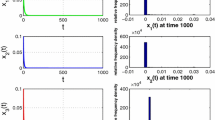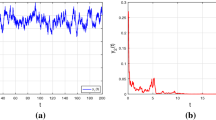Abstract
A two-species competitive system under the influence of random disturbance and toxic substances is studied theoretically and numerically. The existence of a stationary distribution, extinction, and stability of this model are considered. Our results show that both the environmental disturbance and toxic substances can destabilize biological populations. A set of sufficient conditions which guarantee that one of the species is driven to extinction while the other is stable in the mean is illustrated. Numerical simulations are also presented to illustrate the feasibility of our main results.








Similar content being viewed by others
References
Rice, E.I.: Allelopathy, 2nd edn. Academic Press, New York (1984)
Pratt, R.: Influence of the size of the inoculum on the growth of Chlorella vulgaris in freshly prepared culture medium. Am. J. Bot. 27, 52–56 (1940)
Pratt, R., Fong, J.: Studies on Chlorella vulgaris, II. Further evidence that Chlorella cells form a growth-inhibiting substance. Am. J. Bot. 27, 431–436 (1940)
Rice, T.R.: Biotic influences affecting population growth of planktonic algae. US Fish Wildl. Serv. Fish Bull. 54, 227–245 (1954)
Rodhe, W.: Environmental requirements of fresh-water plankton algae: experimental studies in the ecology of phytoplankton. Symb. Bot. Upsal. 1, 1–149 (1948)
Hellebust, J.A.: Extracellular Products in Algal Physiology and Biochemistry. Blackwell Scientific Publication, London (1974)
Renshaw, E.: Modelling Biological Population in Space and Time. Cambridge University Press, Cambridge (1995)
Gard, T.C.: Persistence in stochastic food web models. Bull. Math. Biol. 46, 357–370 (1984)
Gard, T.C.: Stability for multispecies population models in random environments. Nonlinear Anal. 10, 1411–1419 (1986)
Bandyopadhyay, M., Chattopadhyay, J.: Ratio-dependent predator-prey model: effect of environmental fluctuation and stability. Nonlinearity 18, 913–936 (2005)
Sara, P.: The stochastic logistic equation: stationary solutions and their stability. Rendiconti del Seminario Matematico della Università di Padova 106, 165–183 (2001)
Ji, C., Jiang, D., Shi, N.: A note on a predator-prey model with modified Leslie–Gower and Holling-type \(\amalg \) schemes with stochastic perturbation. J. Math. Anal. Appl 377, 435–440 (2011)
Ji, C., Jiang, D.: Dynamics of a stochastic density dependent predator-prey system with Beddington-DeAngelis functional response. J. Math. Anal. Appl. 381, 441–453 (2011)
Hu, G., Wang, K.: Stability in distribution of competitive Lotka–Volterra system with Markovian switching. Appl. Math. Model. 35, 3189–3200 (2011)
Wang, K.: Stochastic Biomathematics Models. Science Press, Beijing (2010)
Turelli, M., Gillespie, J.H.: Conditions for the existence of stationary densities for some two dimensional diffusion processes with applications in population biology. Theor. Popul. Biol. 17, 167–189 (1980)
Li, Z., Chen, F.: Extinction in two dimensional nonautonomous Lotka–Volterra systems with the effect of toxic substances. Appl. Math. Comput. 182, 684–690 (2006)
Chen, F., Li, Z., Chen, X., Laitochová, J.: Dynamic behaviors of a delay differential equation model of plankton allelopathy. J. Comput. Appl. Math. 206, 733–754 (2007)
Li, Z., Chen, F.: Extinction in periodic competitive stage-structured Lotka–Volterra model with the effects of toxic substances. J. Comput. Appl. Math. 231, 143–153 (2009)
Zhang, Y., Zhang, Q.: Dynamic behavior in a delayed stage-structured population model with stochastic fluctuation and harvesting. Nonlinear Dyn. 66, 231–245 (2011)
Xu, Y., Wang, X., Zhang, H., Xu, W.: Stochastic stability for nonlinear systems driven by Lévy noise. Nonlinear Dyn. 68, 7–15 (2012)
Li, X., Liu, X.: Moment Lyapunov exponent and stochastic stability for a binary airfoil driven by an ergodic real noise. Nonlinear Dyn. 73, 1601–1614 (2013)
Maynard Smith, J.: Models in Ecology. Cambridge University Press, Cambridge (1974)
Solé, J., García-Ladona, E., Ruardij, P., Estrada, M.: Modelling allelopathy among marine algae. Ecol. Model 183, 373–384 (2005)
Wang, Y., Yu, Z., Song, X., Zhang, S.: Interactions between the bloom-forming dinoflagellates Prorocentrum donghaiense and Alexandrium tamarense in laboratory cultures. J. Sea Res. 56, 17–26 (2006)
Fergola, P., Cerasuolo, M., Pollio, A., Pinto, G., DellaGreca, M.: Allelopathy and competition between Chlorella vulgaris and Pseudokirchneriella subcapitata: experiments and mathematical model. Ecol. Model. 208, 205–214 (2007)
Wang, Y., Tang, X.: Interactions between Prorocentrum donghaiense Lu and Scrippsiella trochoidea (Stein) Loeblich III under laboratory culture. Harmful Algae 7, 65–75 (2008)
Dubey, B., Hussain, J.: A model for the allelopathic effect on two competing species. Ecol. Model. 129, 195–207 (2000)
Dubey, B., Shukla, J.B., Sharma, S., Agarwal, A.K., Sinha, P.: A mathematical model for chemical defense mechanism of two competing species. Nonlinear Anal. RWA 11, 1143–1158 (2010)
Horsthemke, W., Lefever, R.: Noise Induced Transitions. Springer, Berlin (1984)
Chattopadhyay, J.: Effect of toxic substance on a two-species competitive system. Ecol. Model. 84, 287–289 (1996)
Samanta, G.P.: A two-species competitive system under the inliuence of toxic substances. Appl. Math. Comput. 216, 291–299 (2010)
Liu, Z., Chen, L.: Periodic solution of a two-species competitive system with toxicant and birth pulse. Chaos Solitons Fract. 32, 1703–1712 (2007)
Ikeda, N., Wantanabe, S.: Stochastic Differential Equations and Diffusion Processes. North-Holland Publication and Co., Amsterdam (1981)
Arnold, L.: Stochastic Differential Equations: Theory and Applications. Wiley, New York (1972)
Friedman, A.: Stochastic Differential Equations and Their Applications. Academic Press, New York (1976)
Peng, S., Zhu, X.: Necessary and sufficient condition for comparison theorem of 1-dimensional stochastic differential equations. Stoch. Process. Appl. 116, 370–380 (2006)
Hasminskii, R.: Stochastic stability of differential eauations. In: Mechanics and Analysis, Sijthoff and Noordhoff, Alphen aan den Rijn (1980).
Gard, T.: Introduction to Stochastic Differential Equation. Dekker, New York (1988)
Strang, G.: Linear Algebra and Its Applications. Thomson Learning Inc, Belmont (1988)
Zhu, C., Yin, G.: Asmpptotic properties of hybird diffusion systems. SIAM J. Control Optim 46, 1155–1179 (2007)
Liu, M., Wang, K.: Survival analysis of a stochastic cooperation system in a polluted environment. J. Biol. Syst. 19, 183–204 (2011)
Mao, X., Yuan, C.: Stochastic Differential Equations with Markovian Switching. Imperial College Press, London (2006)
Ahmad, S.: On the nonautonomous Volrerra–Lotka competition equations. Proc. Amer. Math. Soc. 117, 199–204 (1993)
Li, X., Gray, A., Jiang, D., Mao, X.: Sufficient and necessary conditions of stochastic permanence and extinction for stochastic logistic populations under regime switching. J. Math. Anal. Appl. 376, 11–28 (2011)
Acknowledgments
This research was partially supported by grants from the National Natural Science Foundation of PR China (No. 11301207), (No. 11301112), (No. 11171081), (No. 11171056), (No. 11126219), (No. 11001032), (No. 11101183), and (No. 11226254); Project (HIT.NSRIF.2015103) by Natural Scientific Research Innovation Foundation in Harbin Institute of Technology, Natural Science Research Project of Ordinary Universities in Jiangsu Province (No. 13KJB110002).
Author information
Authors and Affiliations
Corresponding author
Rights and permissions
About this article
Cite this article
Wu, R., Zou, X. & Wang, K. Dynamical behavior of a competitive system under the influence of random disturbance and toxic substances. Nonlinear Dyn 77, 1209–1222 (2014). https://doi.org/10.1007/s11071-014-1371-8
Received:
Accepted:
Published:
Issue Date:
DOI: https://doi.org/10.1007/s11071-014-1371-8




